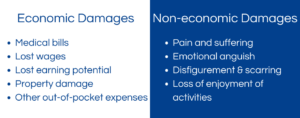In California personal injury cases, compensatory damages are the money that a wrongdoer pays in order to compensate you for losses. This is distinguished from punitive damages, which are intended to punish the wrongdoer and discourage others from similar behavior.
Compensatory damages – also called actual damages – fall into two basic categories, as the following graphic shows:

To help you better understand what compensatory damages are in a personal injury case, our California personal injury lawyers discuss, below:

Compensatory damages are meant to reimburse you for your damages.
Economic Damages
Your “economic damages” are those to which a dollar amount can readily be attached. Also called “special damages,” economic damages are intended to cover “out-of-pocket” amounts you actually spent or will be required to spend in the future.
Economic losses often include (but are not limited to):
- Past and future medical expenses (including for mental health medical treatments, prescription drugs, home health care, etc.),
- Property damage,
- Lost wages / loss of earnings, and
- Lost earning capacity.1
Non-Economic Damages
Non-economic damages do not necessarily involve out-of-pocket expenses or a particular sum of money. Also called “general damages,” non-economic damages include more subjective losses such as:
- Pain and suffering,
- Emotional distress and mental anguish,
- Physical impairment (such as loss of the use of a limb or organ),
- Disfigurement,
- Unjust hardship,
- Loss of consortium,
- Inconvenience, and
- Loss of enjoyment of life.2
Damage Caps
In general, California state law places no cap on the amount of compensatory damages in a personal injury case. The jury (or, in a bench trial, the judge) can award any fair and reasonable monetary award.
In medical malpractice cases, however, there is a cap on pain and suffering and other non-economic damages. As of January 1, 2024, the cap is:
- $390,000 in non-fatality cases. Each new year this cap rises by $40,000 until it hits $750,000.
- $550,000 in wrongful death cases. Each new year this cap rises by $50,000 until it hits $1 million.3
With regard to punitive damages, although there is no cap, they cannot be grossly excessive or arbitrary.
Additional Reading
For more in-depth information, refer to these scholarly articles:
- The Remedies Issues: Compensatory Damages, Specific Performance, Punitive Damages, Supersedeas Bonds, and Abstention – Review Litigation.
- Lost punitive damages as compensatory loss – Defense Counsel Journal.
- Assessing Economic Damages in Personal Injury and Wrongful Death Litigation: The State of California – Journal of Forensic Economics.
- Interest as Damages in California – UCLA Law Review.
- Measurement of Restitution: Coordinating Restitution with Compensatory Damages and Punitive Damages – Washington & Lee Law Review.
Legal References:
- CACI 3909. See, for example: Williams v. The Pep Boys Manny Moe & Jack of California (2018) 27 Cal.App.5th 225; Gutierrez v. Cassiar Mining Corp. (1998) 64 Cal.App.4th 148; Martinez v. State Dept. of Health Care Services (2017) 19 Cal.App.5th 370.
- CACI 3905. See, for example: Pearl v. City of Los Angeles (2019) 36 Cal.App.5th 475; Bigler-Engler v. Breg, Inc. (2017) 7 Cal.App.5th 276; Wilson v. Southern California Edison Co. (2015) 234 Cal.App.4th 123.
- California Civil Code 3333.2(b). Fein v. Permanente Medical Group (1985) 38 Cal.3d 137. Assembly Bill 35 (2022).
